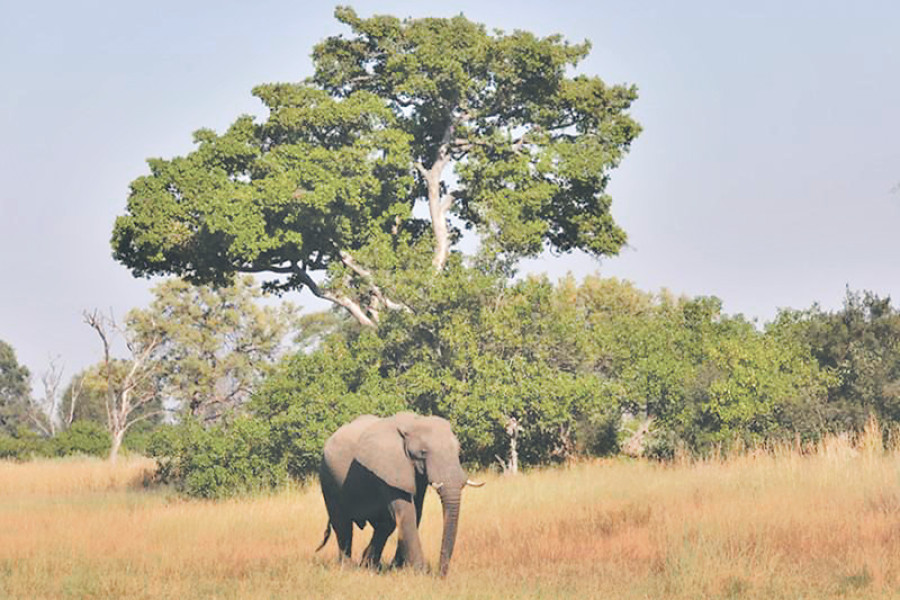Opinion
On pachyderms
When the elephnat goes, we will lose over 100 varieties of trees and bushes
Maneka Sanjay Gandhi
We may pride ourselves that we have 26,000 elephants— but we avoid saying that these are what is left of a several lakh population of elephants, and that it decreases every year. We have only about a thousand tuskers, so the gene pool is very diluted. The worst is that we have 3,500 elephants in captivity.
The elephant is a wild being whose intelligence is as great as ours and whose extra sensory perception is perhaps much greater. Such an animal, a being who dreams and aspires, cannot be tamed. He/she can be subdued with whips and chains and blindings and starvation, but the spirit remains wild. The kraals of Tamil Nadu are famous—you put a elephant into a tight enclosure and then you keep beating it for months till it can barely stand. Then if it recovers, you chain it for life and sell it to a temple, or to a professional
beggar.
There are 40 elephants in Karnataka and 40 in Tamilnadu in the temples. They live alone, tethered permanently outside the temple premises. Most of them suffer from tuberculosis. Why do these temples keep them? To earn money from tourist festivals and begging. No forest officers, or doctors, are trained in elephant management or elephant medicine.What is a common way of killing an elephant and claiming insurance? You make the elephant walk on rusted nails. She gets gangrene and dies in agony, and you collect the money. Or, you wrap heavy iron chains round her and push her into the water to drown.
Are temples the only culprits? Delhi had 23 elephants rented out daily, to advertise products to walk the streets with heavy wooden banners on their sides. They eat on the move—plucking the leaves of pipal trees. Of these, only 6 remain. The rest have been mowed down by vehicles. The six were ordered to be removed from Delhi 4 years ago. The Chief Wildlife Warden will not do so because the owners earn money and will do ‘anything’ to stop the elephants from being moved. Two elephants were struck by a truck some years ago. One was killed outright. The other broke her legs and ribs. The owner abandoned her in the middle of the road and ran away. She was taken at private expense to an elephant sanctuary in Mathura and nursed back to health. As soon as she was well the owner claimed her back, even though he had no papers for ownership and should have been in jail.
Circuses have been forbidden to keep elephants. But several of them still keep them, and they are dragged from district to district. Zoos have been banned from keeping elephants. 64 still remain in state zoos that refuse to surrender them. The single government rescue centre, made by Haryana twenty years ago, lies empty, because the government will not allocate any money to keep a single suffering confiscated animal. Maharajas of Kuchnahipurand Talukdars, who own a little land, keep elephants and rent them out for weddings and elections.
Recent investigations have found that the people who hold the elephants captive do so illegally—without a valid ownership certificate from the authorities, or any other documents as required by the law.
According to a study led by Baskaran in 2011, a sample of 1,545 elephants, covering 13 different states and 6 different management regimes, has shown that only 44 percent of captive elephants have ownership certificates, and only 48 percent of those captive elephants have been implanted with microchips This is corroborated by the findings of the Animal Welfare Board of India (AWBI).
But it is difficult to understand how any of these groups, or individuals, can keep elephants. When the Wildlife (Protection) Act, 1972, was passed it clearly said that the elephants that were already owned could stay with their owners. But not a single new elephant could be added. But the elephants in custody now are all young. They were not even born in 1972. How can they be allowed to be kept? In this dark, dark scenario there are a few rays of light. The Sonpur mela in Bihar has been banned from displaying elephants for sale. It was the main selling market in India. While it may have no effect on the illegal trade, now poachers, buyers and sellers will have to be even more secretive, instead of openly flouting the law.
However, it is not just the elephants in captivity that ensure cruelty. Our elephants in the wild are not safe either. Shrinking habitats, in the garb of mindless development, are resulting in a constant conflict between man and animal. Reports of brutal attacks on elephant herds, that wander into human settlements, are on the rise. Illegally installed electric fences with enough voltage to kill the largest land mammal, and irresponsibly laid railway lines in forest areas and elephant corridors, are all contributing to diminishing their population. The railways do their own share of decimating them. In the last ten years more than 500 elephants have been killed, simply because the train would not slow down on seeing a herd crossing the track. Nor do the railways listen to advice on how to handle the crossings––developing underpasses, installation of animal detection systems, getting rid of steep embankments, continuous whistling and slowing down in recognized elephant corridors.
This is a major crisis. 26,000 today, from 30,000 last year, means they will be gone in twenty years. The report Gaja, submitted by the Elephant Task Force constituted by the MOEF, has recommended that elephants be phased out of all commercial use, including logging.
At least 20 rescue & rehabilitation centres must be established, and the elephants in private ownership must be re-homed on priority. Sustainable development plans must take into consideration the natural habitats, ensuring that we protect our elephant herds on the ground and not just on paper. There are 101 identified elephant corridors. None of them have been secured by the government. We have fragmented their habitat, and allowed illegal villages who deny them any right of way. We even had an Environment Minister who stated that elephants must be killed as revenge for every human that is hurt by them—even if the human is in the wrong.
India prides itself on its compassion. In actual fact we show none to any beings, including our own species. The elephant is an example of our own viciousness and shortsightedness. When the elephant finally goes, we will lose over 100 varieties of trees and bushes whose seeds are spread by its dung. God knows what else we will lose—apart from our souls.
To join the animal welfare movement contact [email protected], www.peopleforanimalsindia.org




 7.12°C Kathmandu
7.12°C Kathmandu










